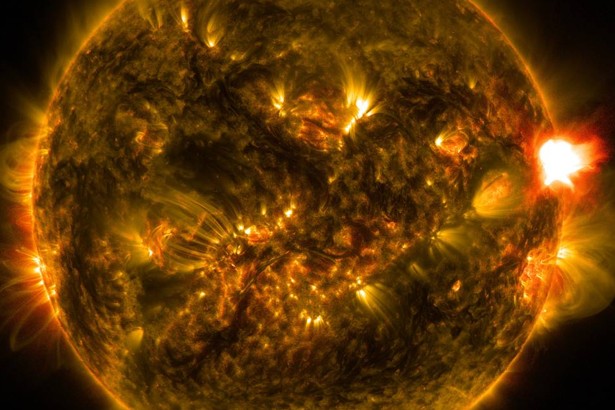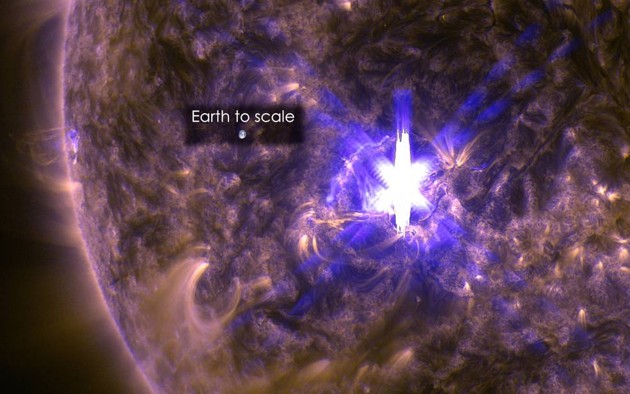
Solar storms are brutal events on Mars. Without a global magnetic shield for protection, the planet gets battered by the radiation from super-hot plumes of plasma. Today, Mars’s atmosphere is mostly made up of carbon dioxide. During solar storms, the planet is bombarded with sun particles moving a million miles an hour, and Mars loses oxygen atoms at a rate 10 times greater than what occurs on Earth under the same conditions.
Now, new research from the MAVEN mission finds dramatic climate change on Mars may have been driven by solar storms, too. These violent storms may be key to helping humans understand what happened to Mars’s atmosphere, the loss of which transformed the planet from something that might have once resembled Earth to the dry wasteland it is today.
“When we look at ancient Mars we see a different type of surface, one that had valleys that look like they were carved by water, lakes that were standing for long periods of time,” said Bruce Jakosky, the principal investigator at the University of Colorado’s Laboratory for Atmospheric and Space Physics, in a press conference on Thursday. “The climate must’ve been very different, warmer and wetter, and the atmosphere must’ve been thicker at that time in order to sustain a warmer climate. So what happend to the carbon dioxide from that early atmosphere? What happened to the water on early Mars?”
Earlier this year, over the course of a few weeks in late February and early March, a team of MAVEN researchers observed a “major interplanetary disturbance,” prompted by one of the most dramatic solar storms recorded in the past decade. The coronal mass ejections that take place during this kind of solar storm are so strong they can make the entire surface of the sun appear to ripple. Here’s a video from the Solar Dynamics Observatory of one significant solar flare that occurred at the time:
And here’s a look at the size of our planet compared with the magnitude of a particularly powerful solar flare that was observed on March 11, 2015, and given the X-class designation, reserved for the most intense solar flares:

It was days after that flare when planetary scientists first noticed a surprisingly bright, ultraviolet aurora glowing deep in the Martian atmosphere, “a new kind of aurora was observed at Mars that, frankly, surprised us,” said Dave Brain, a MAVEN co-investigator. This storm, Brain and his colleagues would later learn, didn’t just create a strange aurora. It drastically altered the overall structure and flow of the magnetosphere on Mars and had a “major impact” on the upper atmosphere, too.
Normally, when Mars isn’t being blasted by solar wind, “there are roughly 100 grams of atmosphere escaping every second, or about a quarter-pound of atmosphere escaping every second,” said Brain. (“I can’t help but imagine hamburgers flying out of the Martian atmosphere, one per second,” he added.)
During a solar storm, the new data shows, atmospheric escape rates go up by a factor of 10 to 20 at least. MAVEN's work represented the most comprehensive mapping of ion loss on the planet to date.
The findings, which researchers detailed in Science on Thursday, also suggest that solar winds play a major role in atmospheric loss on Mars. Scientists believe much higher escape-rates early in Mars’s history were dominated by storm events. Which means that by observing the way that ions flood out of Mars’s upper atmosphere before and after the solar storm in March, scientists believe they are able to piece together how Mars lost so much of its atmosphere.
Another new paper from MAVEN researchers focuses on the new kind of auroral display identified on Mars.
This new aurora is similar to Earth’s Northern Lights in some ways, but powered by a different mechanism, scientists found. While both kinds of auroras involve accelerated particles along electromagnetic fields, Earth’s auroras are driven by the magnetism of the planets poles, whereas the aurora observed on Mars seems to be driven at least in part by remnant magnetism of the planet’s crust. (Other areas of magnetism on the Red Planet are associated with solar-wind fields, magnetic plasma that gets draped around Mars, and changes location around the planet over time.) The effect is a light show that spans a much wider area on Mars.“Diffuse auroras on Mars could therefore occur practically anywhere, and potentially nearly everywhere, on the planet,” researchers wrote in their paper.
And although scientists haven’t yet seen these diffuse auroras with the naked eye, the visual effect is potentially awe-inspiring. “It's possible that the new kind of aurora lights up the entire night sky over much of the planet,” Brain said. “So that if you’re standing on the night side of Mars ... you could see the whole sky lighting up... It would be magnificent.”
These findings also underscore the unusual magnetism of the planet, which has implications for our understanding of its stark atmospheric changes over time.
Mars only has a partial magnetic field, and it comes from magnetism locked into the crust billions of years ago. On Earth, the internally generated magnetic field is like a protective cocoon that surrounds that globe. Mars’s auroras are more like the ones that occur on Venus and some of Jupiter's biggest moons, which also lack global magnetic fields.
Better understanding how and why certain kinds of auroral displays are generated on Mars is another way of getting at the question of how its atmosphere was lost. That’s because increased rates of atmospheric escape are associated with diffuse auroras, the kind scientists have identified on the Red Planet. In other words, the same solar storms that can generate intense auroras across Mars appear to be responsible for accelerating planet’s atmospheric loss.
This is, however, only part of the puzzle. “Mars lost its atmosphere,” said Michael Meyer, the lead scientist for NASA’s Mars Exploration Program, in a press conference Thursday. “The atmosphere of mars could have frozen out, it could've been turned into rocks, it could've been knocked off by asteroids or comets, or it could've been stripped off by the solar wind.”
And although scientists may be able to eventually determine with confidence how the Martian atmosphere went away, they already know it isn’t coming back.
“People talk about terraforming Mars, taking the [carbon dioxide] that might be locked up in the crust and putting it back in the atmosphere,” said Jakosky. “If that’s where all the [carbon dioxide] had gone, that might be possible. But with it having been stripped away from space, it’s not there. It’s been removed from the solar system entirely, so it’s not possible to bring it back.”